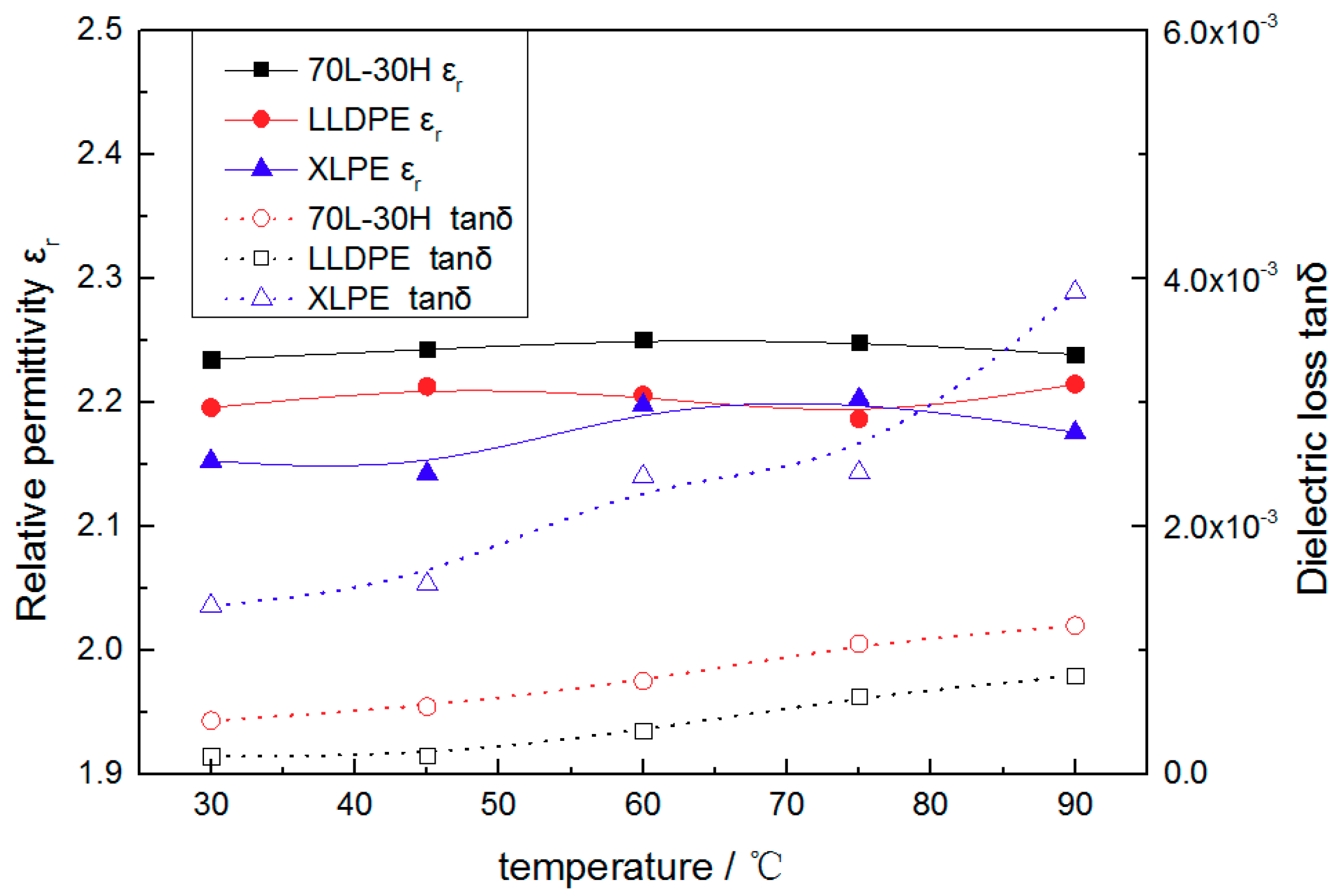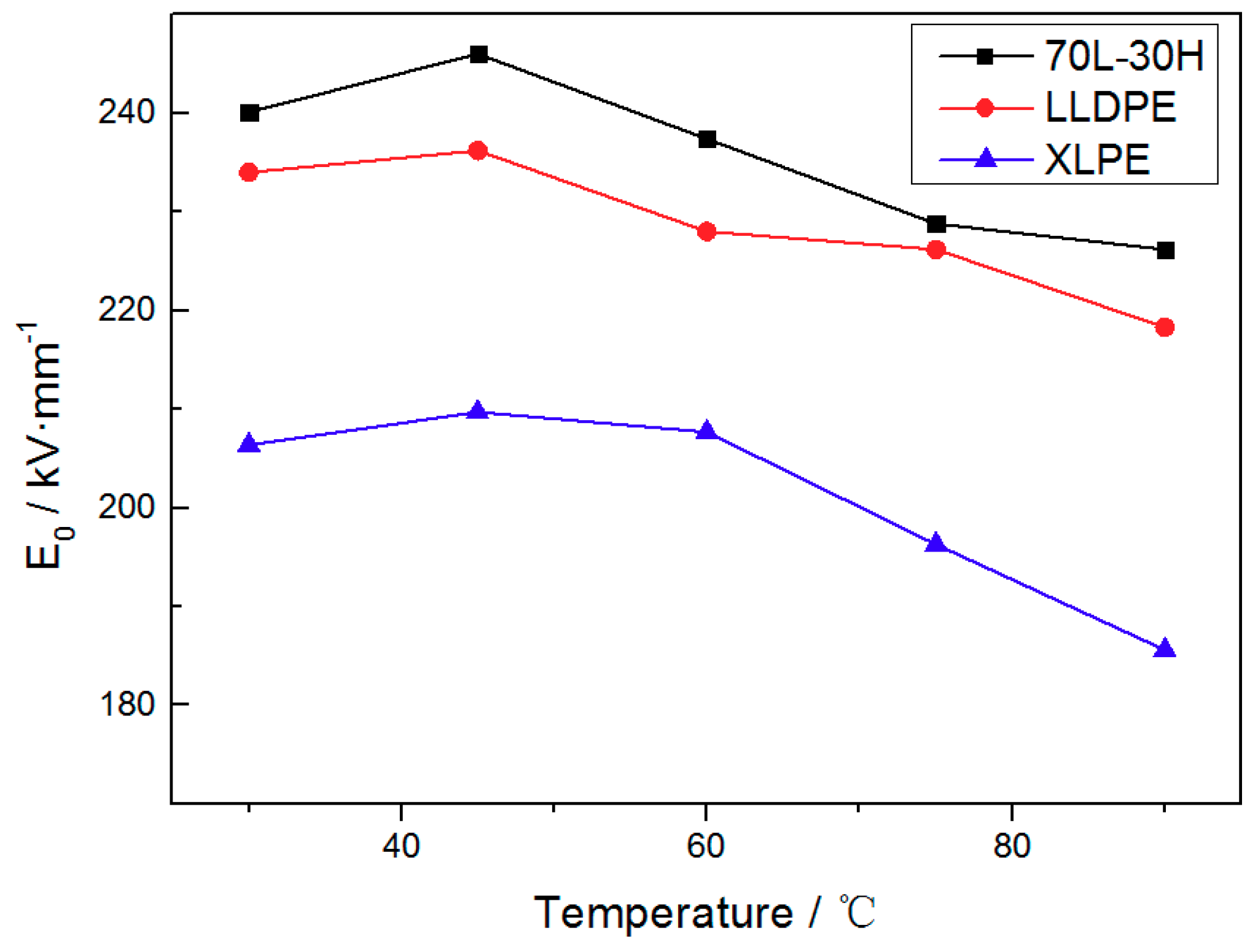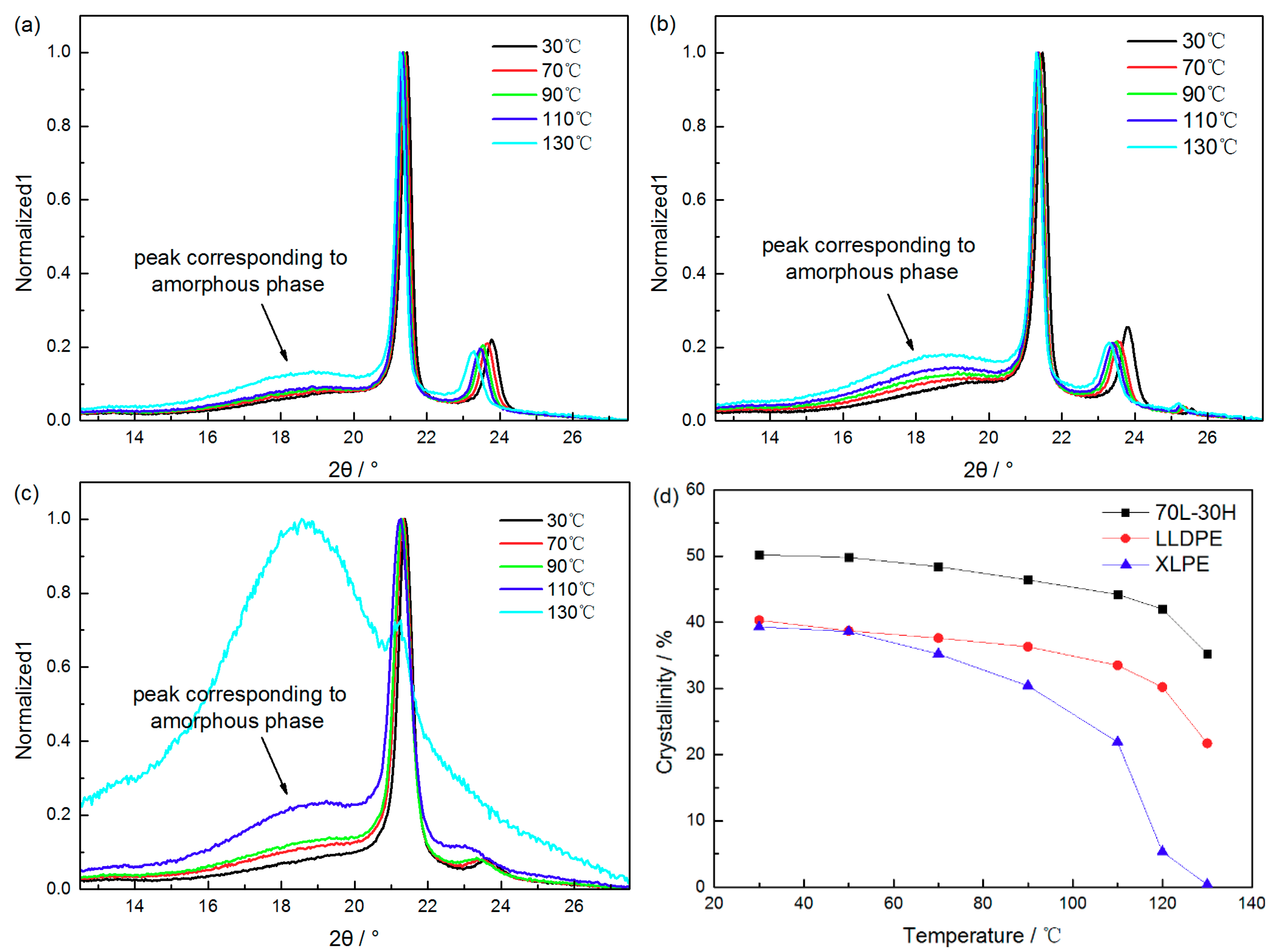Temperature Dependence of Mechanical, Electrical Properties and Crystal Structure of Polyethylene Blends for Cable Insulation
Abstract
:1. Introduction
2. Materials and Methods
2.1. Sample Preparation
2.2. Electrical Properties Tests
2.3. Mechanical Properties Tests
2.4. Morphological Structure Characterization
3. Results
3.1. Temperature Dependence of Electrical Properties
3.2. Temperature Dependence of Mechanical Properties
3.3. Structure Characterization
4. Discussion
5. Conclusions
Author Contributions
Funding
Acknowledgments
Conflicts of Interest
References
- Gwon, S.; Jang, S.Y.; Shin, M. Combined effects of set retarders and polymer powder on the properties of calcium sulfoaluminate blended cement systems. Materials 2018, 11, 825. [Google Scholar] [CrossRef] [PubMed]
- Salehabadi, A.; Bakar, M.A.; Bakar, N.H.H.A. Effect of organo-modified nanoclay on the thermal and bulk structural properties of poly(3-hydroxybutyrate)-epoxidized natural rubber blends: Formation of multi-components biobased nanohybrids. Materials 2014, 7, 4508–4523. [Google Scholar] [CrossRef] [PubMed]
- Qiang, T.; Wang, J.; Wolcott, M.P. Facile fabrication of 100% bio-based and degradable ternary cellulose/phbv/pla composites. Materials 2018, 11, 330. [Google Scholar] [CrossRef] [PubMed]
- Arrieta, M.P.; Samper, M.D.; Aldas, M.; López, J. On the use of pla-phb blends for sustainable food packaging applications. Materials 2017, 10, 1008. [Google Scholar] [CrossRef] [PubMed]
- Fairhurst, M.; Gorwadia, A.; Stevens, G.; Philpot, B.; Thomas, J.; Pilgrim, J.; Lewin, P. Integrated development and assessment of new thermoplastic high voltage power cable systems. CIGRE 2012, B1–B215. [Google Scholar]
- Stevens, G.; Philpot, B.; Thomas, J.; Fairhurst, M.; Gorwadia, A. Whole-life costs and environmental assessment of high voltage power cable systems. In Proceedings of the 8th International Conference on Insulated Power Cables (JICABLE), Versailles, France, 20–23 June 2011. [Google Scholar]
- Stevens, G.; Mitchell, A.; Scobie, P.; Culley, D.; Fitch, J. New life cycle costing and risk approaches to asset investment and planning. In Proceedings of the 21st International Conference on Electricity Distribution (CIRED), Frankfurt, Germany, 6–9 June 2011. [Google Scholar]
- Hosier, I.L.; Vaughan, A.S.; Swingler, S.G. Structure–property relationships in polyethylene blends: The effect of morphology on electrical breakdown strength. J. Mater. Sci. 1997, 32, 4523–4531. [Google Scholar] [CrossRef]
- Hosier, I.L.; Vaughan, A.S.; Swingler, S.G. On the effects of morphology and molecular composition on the electrical strength of polyethylene blends. J. Polym. Sci. Pol. Phys. 2000, 38, 2309–2322. [Google Scholar] [CrossRef]
- Green, C.D.; Vaughan, A.S.; Stevens, G.C.; Sutton, S.J.; Geussens, T.; Fairhurst, M.J. Electrical and mechanical properties of new recyclable power cable insulation materials based upon polyethylene blends. In Proceedings of the XVII International Symposium on High Voltage Engineering, Hannover, Germany, 22–26 August 2011. [Google Scholar]
- Green, C.D.; Vaughan, A.S.; Stevens, G.C.; Sutton, S.J.; Geussens, T.; Fairhurst, M.J. Recyclable power cable comprising a blendof slow-crystallized polyethylenes. IEEE Trans. Dielectr. Electr. Insul. 2013, 20, 1–9. [Google Scholar] [CrossRef]
- Zhou, Y.; He, J.; Hu, J.; Huang, X.; Jiang, P. Evaluation of polypropylene/polyolefin elastomer blends for potential recyclable HVDC cable insulation applications. IEEE Trans. Dielectr. Electr. Insul. 2015, 22, 673–681. [Google Scholar] [CrossRef]
- Zhang, W.; Xu, M.; Chen, G.; Hou, S.; Fu, M.; Li, W. Structure and properties of isotactic polypropylene and ethylene-propylene copolymer. High Volt. Eng. 2017, 43, 3634–3644. [Google Scholar]
- Green, C.D.; Vaughan, A.S.; Stevens, G.C.; Pye, A.; Sutton, S.J.; Geussens, T.; Fairhurst, M.J. Thermoplastic cable insulation comprising a blend of isotactic polypropylene and a propylene-ethylene copolymer. IEEE Trans. Dielectr. Electr. Insul. 2015, 22, 639–648. [Google Scholar] [CrossRef] [Green Version]
- Li, L.; Zhang, K.; Zhong, L.; Chen, N.; Xu, M.; Xie, D.; Chen, G. Dielectric behaviors of recyclable thermo-plastic polyolefin blends for extruded cables. In Proceedings of the 11th International Conference on the Properties and Applications of Dielectric Materials (ICPADM), Sydney, Australia, 19–22 July 2015; pp. 180–183. [Google Scholar]
- Li, L.; Zhang, K.; Zhong, L.; Chen, G.; Hou, S.; Fu, M. The characteristics of recyclable thermoplastic materials based on polyethylene blends for extruded cables. In Proceedings of the 9th International Conference on Insulated Power Cables (JICABLE), Versailles, France, 21–25 June 2015. [Google Scholar]
- Zhang, K.; Li, L.; Zhong, L.; Chen, N.; Xu, M.; Xie, D.; Chen, G. The mechanical properties of recyclable cable insulation materials based on thermo-plastic polyolefin blends. In Proceedings of the 11th International Conference on the Properties and Applications of Dielectric Materials (ICPADM), Sydney, Australia, 19–22 July 2015; pp. 532–535. [Google Scholar]
- Zhang, K.; Li, L.; Zhong, L.; Cao, L.; Xu, M.; Chen, G.; Fu, M. DC dielectric properties of thermo-plastic polyolefin materials. In Proceedings of the IEEE Electrical Insulation & Dielectric Phenomena (CEIDP), Toronto, ON, Canada, 16–19 October 2016; pp. 470–473. [Google Scholar]
- Li, L.; Zhang, K.; Zhong, L.; Gao, J.; Xu, M.; Chen, G.; Fu, M. Treeing phenomenon of thermoplastic polyethylene blends for recyclable cable insulation materials. Aip Adv. 2017, 7, 025116. [Google Scholar] [CrossRef] [Green Version]
- Blythe, A.R.; Bloor, D. Electrical Properties of Polymers, 2nd ed.; Cambridge University Press: Cambridge, UK, 2005. [Google Scholar]
- Zhang, K.; Zhong, L.; Gao, J.; Li, L.; Cao, L.; Chen, G. Temperature Dependence of Crystalline Structure and DC Performance in LLDPE/HDPE Blending Material. IEEE Trans. Dielectr. Electr. Insul. 2018, in press. [Google Scholar]
- Dissado, L.A.; Fothergill, J.C. Electrical Degradation and Breakdown in Polymers, 1st ed.; The Institution of Engineering and Technology: London, UK, 1992. [Google Scholar]
- Stark, K.H.; Garton, C.G. Electric strength of irradiated polythene. Nature 1955, 176, 1225–1226. [Google Scholar] [CrossRef]
- Parkman, N.; Goldspink, G.F.; Lawson, W.G. Effect of pressure and constraint on the apparent electric strength of polythene. Electron. Lett. 1965, 1, 98–100. [Google Scholar] [CrossRef]
- Blok, J.; Legrand, D.G. Dielectric Breakdown of Polymer Films. J. Appl. Phys. 1969, 40, 288–293. [Google Scholar] [CrossRef]
- Fothergill, F.C. Filamentary Electromechanical Breakdown. IEEE Trans. Dielectr. Electr. Insul. 1991, 26, 1124–1129. [Google Scholar] [CrossRef]
- Kolesov, S.N. The influence of morphology on the electric strength of polymer insulation. IEEE Trans. Dielectr. Electr. Insul. 1980, 5, 382–388. [Google Scholar] [CrossRef]
- Dang, B.; He, J.; Hu, J.; Zhou, Y. Large improvement in trap level and space charge distribution of polypropylene by enhancing the crystalline − amorphous interface effect in blends. Polym. Int. 2016, 65, 371–379. [Google Scholar] [CrossRef]
- Viana, J.C.; Cunha, E.M. Extensibility of the inter-lamellar amorphous layer and the mechanical behavior of polyethylene. Mater. Sci. Forum. 2006, 514–516, 1186–1190. [Google Scholar] [CrossRef]
- Sun, X.; Shen, H.W.; Xie, B.H.; Yang, W.; Yang, M. Fracture behavior of bimodal polyethylene: Effect of molecular weight distribution characteristics. Polymer 2011, 52, 564–570. [Google Scholar] [CrossRef]






| Materials | M’(30 °C)/MPa | M’(120 °C)/MPa | M’(120 °C)/M’(20 °C) |
|---|---|---|---|
| 70 L-30 H blends | 857 | 33 | 0.038 |
| LLDPE | 655 | 14.5 | 0.022 |
| XLPE | 221 | 0.57 | 0.0025 |
© 2018 by the authors. Licensee MDPI, Basel, Switzerland. This article is an open access article distributed under the terms and conditions of the Creative Commons Attribution (CC BY) license (http://creativecommons.org/licenses/by/4.0/).
Share and Cite
Li, L.; Zhong, L.; Zhang, K.; Gao, J.; Xu, M. Temperature Dependence of Mechanical, Electrical Properties and Crystal Structure of Polyethylene Blends for Cable Insulation. Materials 2018, 11, 1922. https://doi.org/10.3390/ma11101922
Li L, Zhong L, Zhang K, Gao J, Xu M. Temperature Dependence of Mechanical, Electrical Properties and Crystal Structure of Polyethylene Blends for Cable Insulation. Materials. 2018; 11(10):1922. https://doi.org/10.3390/ma11101922
Chicago/Turabian StyleLi, Lunzhi, Lisheng Zhong, Kai Zhang, Jinghui Gao, and Man Xu. 2018. "Temperature Dependence of Mechanical, Electrical Properties and Crystal Structure of Polyethylene Blends for Cable Insulation" Materials 11, no. 10: 1922. https://doi.org/10.3390/ma11101922





